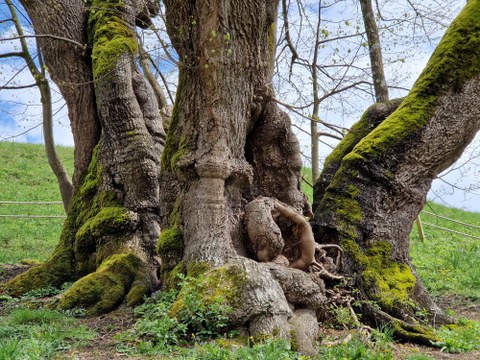Nov 03, 2023
Aging with dignity: 30th national heritage tree honored – initiative to protect old trees reaches milestone

Heritage Tree Tassilolinde
More than 14 meters trunk circumference, 17 meters tall and about 800 years old: The Tassilolinde tilia tree, stands on an idyllic hillside in Wessobrunn in Upper Bavaria, was officially named Germany's 30th National Heritage Tree by the German Dendrological Society (DDG) on October 14. The society and the initiator of the initiative, the Dresden forest scientist Prof. Andreas Roloff, have thus come a major step closer to their ambitious goal of awarding this seal to 100 trees in all German regions within ten to fifteen years.
The initiative to protect old trees was launched in fall 2019. Their model was Great Britain, where for the past 40 years, these Methuselah trees of sometimes more than 1000 years of age have been specially honored and protected by being designated as "National Heritage Trees". "In contrast, we didn't have any suitable protection categories for particularly old trees in Germany until now," explains Prof. Andreas Roloff, who has specialized in the study of old trees throughout his life as a scientist. "The fact that we don't have any trees that are over 1000 years old in our country is only partly due to our history. Rather, old trees are increasingly perceived only as safety hazards and are cut down or felled as a result." Through the "National Heritage Trees" initiative, the former director of the Institute of Forest Botany and Forest Zoology and the Forest Botanical Garden in Tharandt wants to draw attention to the ecological as well as the cultural historical and social value of old trees. In the DDG he found an enthusiastic partner with great expertise. The third partner in the alliance is the Eva Mayr-Stihl Foundation, which will cover all costs for care and protection measures as well as the proclamation ceremonies for an initial 50 trees.
"Such specimens should only be cared for by highly qualified experts, as over the centuries, the trees themselves have usually developed strategies to adapt to changing events, changes and variabilities in the location, environment and climate," explains Roloff: "Nevertheless, the cost of this work for some of these Methuselahs should not be underestimated and can be hard to cover for municipalities, districts, churches or private owners on their own."
Nonetheless, there is great enthusiasm when a national heritage tree is honored there. "So far, it has always been a special event for the experts and the local people. This is because these old trees have their own stories, most of which are very moving, exciting or unusual and closely related to their place," the forest scientist recounts.
On the occasion of the 30th honoring, Roloff and the DDG published the book “Nationalerbe-Bäume” (National Heritage Trees) in October, in which all the trees honored so far are presented with their stories in words and pictures. Moreover, the book contains a short scientific classification, including information on which specific requirements must be met in terms of age and trunk circumference in order to qualify as a national heritage tree, and which tree species have the potential to ever live to be 1,000 years old. Tilia trees are definitely among them. However, this rather holds true for large-leaved linden than for small-leaved linden. Which also applies to the Tassilolinde in Upper Bavaria. "It was a surprise when I realized that it had previously been incorrectly listed as a small-leaved linden. To my relief, this was well received locally," Roloff reports.
When Roloff studied the tree, he was also able to define its age relatively well. It has nothing to do with the namesake Duke Tassilo III and the legend of the foundation of the monastery over 1000 years ago. More likely is the temporal connection with the end of the monastery over 750 years ago. "For me, the analysis was exciting as rarely before. While examining the trunk structures, I came across a remnant of the original trunk, which indicates an age of about 700 to 800 years," the scientist explains enthusiastically.
- Overview of all national heritage trees: https://nationalerbe-baeume.de/nationalerbe-baeume
- The Tassilolinde Wessobrunn: https://nationalerbe-baeume.de/2023/08/11/tassilolinde-wessobrunn-nahe-ammersee-oberbayern-als-nationalerbe-baum-ausgewaehlt/
- Andreas Roloff / Deutsche Dendrologische Gesellschaft (2023): Nationalerbe-Bäume – Ziele, Konzeption und Stand der Umsetzung – zum Schutz alter Bäume in Deutschland – including the first 30 candidates (Oct. 2023) for download: https://nationalerbe-baeume.de/2023/10/15/2-buch-neuerscheinung-zur-initiative
Contact:
TU Dresden Press Office
Tel.: +49 351 463-32398
Prof. Andreas Roloff
Chair of Forest Botany and German Tree Institute
